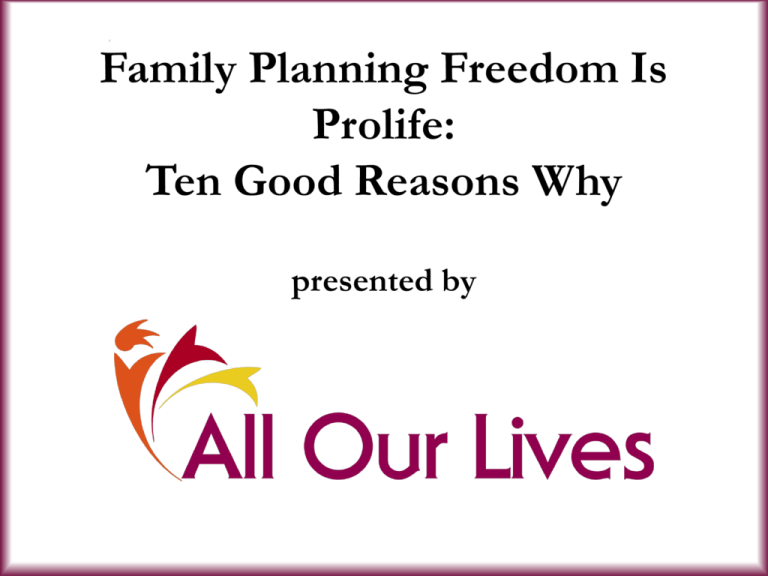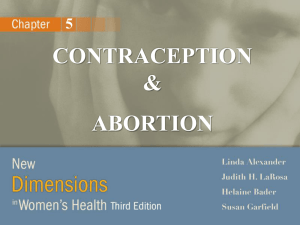
Family Planning Freedom Is
Prolife:
Ten Good Reasons Why
presented by
Our Definition of “Prolife”
Respect in deed that:
• Encompasses both the lives of women and
children, as well as men’s lives.
• Covers all phases of the life cycle – before, during,
and ever after birth, starting at conception but
hardly ending there.
• Is grounded in universal human rights and
nonviolence towards all.
• Can be practiced by people of all religions and no
religion.
Ten Good Reasons Why Family
Planning Freedom Is Prolife
1. It prevents millions of maternal and child deaths
every year.
2. It measurably reduces abortion rates.
3. It is a critical solution to the overlapping
injustices of violence against women and
abortion.
4. Contraceptives truly prevent rather than take
lives.
5. Contraception can be and is widely practiced
without a “contraceptive mentality.”
Ten Good Reasons Why Family
Planning Freedom Is Prolife
6. Some contraceptives help prevent HIV/AIDS.
7. Most abortion opponents favor contraception.
8. Family planning freedom is a recognized
universal human right, one that encompasses all
prevention methods…
9. …and includes the freedom to bear a child.
10.Contraception secures the sexual/reproductive
and life rights of people with disabilities.
1.
Family Planning Freedom
Prevents Millions of Maternal
and Child Deaths Every Year.
Every year, around the world, access to modern, voluntary family
planning methods prevents:
•
•
•
•
112.3 million induced abortions.
21.94 million miscarriages.
1.17 million newborn deaths.
230,000 maternal deaths.
Family planning freedom empowers women to:
•
Plan their childbearing for when they are healthiest & most able to
care for children.
• Forego conception altogether (for those wish it).
• Select the safest, most effective method(s) for their own personal
circumstances.
(Guttmacher Institute & UNFPA, “Adding It Up: The Costs & Benefits of Investing in Family Planning & Maternal & Newborn
Health,” 2009, page 18,
http://www.unfpa.org/webdav/site/global/shared/documents/publications/2009/adding_it_up_report.pdf)
• # women globally who want but cannot access modern,
voluntary family planning methods: 215 million, mostly in the
Two Thirds World.
• # abortions prevented if 100 million of these women have
access by 2015: 54 million.
• # global maternal deaths from abortion (along with
accompanying prenatal deaths) preventable by making family
planning available to this gravely unserved population: 90 %.
(John Cleland et al., “Family Planning: The Unfinished Agenda,” The Lancet, 18 November 2006; Reproductive Health Supplies Coalition: Hand to
Hand Campaign, http://www.rhsupplies.org/handtohand-campaign/handtohand-campaign.html ;
UNFPA Fact Sheet: “Contraceptives Save Lives,”
http://www.unfpa.org/webdav/site/global/shared/safemotherhood/docs/contraceptives_factsheet_en.pdf )
2.
Family Planning Freedom
Measurably Reduces Abortion
Rates.
World’s highest abortion rates:
• Vietnam and Cuba.
Family planning access = extremely limited.
World’s lowest:
• Netherlands and Belgium.
Family planning access = excellent.
(Family Health International: “Increasing Contraception Reduces Abortions,”
http://www.fhi.org/en/RH/Pubs/Network/v21_4/NWvol21-4abortcontception.htm
Dramatically improved contraceptive quality
and access:
• Over the 1990s, reduced onceastronomical abortion rates of formerly
Soviet-dominated nations between 25%
and 50%.
• Created similar effect in Bangladesh.
(Family Health International: “Increasing Contraception Reduces Abortions,”
http://www.fhi.org/en/RH/Pubs/Network/v21_4/NWvol21-4abortcontception.htm)
Only one known kind of exception to
“contraception reduces abortion”:
• Problem: When the desire/need for smaller
families outstrips the availability of family
planning.
• Solution: A planned scaleup of services that
stays ahead of growing demand.
• In other words, the solution is more, not less,
contraceptive access.
(Family Health International: “Increasing Contraception Reduces Abortions,”
http://www.fhi.org/en/RH/Pubs/Network/v21_4/NWvol21-4abortcontception.htm)
3.
Family Planning Freedom Is a
Critical Solution to the
Overlapping Injustices of
Violence Against Women and
Abortion.
1 in 3 women worldwide are subjected to gender-based violence,
including intimate partner violence (IPV), which may involve:
• Sexual assault and contraceptive sabotage--thus heightened
risk for/ incidence of unintended pregnancies.
• Inhospitable circumstances for women to continue pregnancies
and raise the children.
• Outright, directly forced abortions.
• Insistence that pregnancies continue, while withholding
necessary supports; motive of control and domination rather
than concern for mother and baby.
• Homicide of mother and/or child.
(UNWomen: “Facts and Figures on VAW,” http://www.unifem.org/gender_issues/violence_against_women/facts_figures.php ;
Family Violence Prevention Fund: The Facts on Reproductive Health and Partner Abuse, http://www.knowmoresaymore.org/wpcontent/uploads/2008/07/factsheet-on-rh-and-dv-nov-2010.pdf ;
V. Escribà-Agüir et al., “Violence in the Lives of Women in Italy Who Have an Elective Abortion,” Women’s Health Issues
[September/October 2009], http://www.ncbi.nlm.nih.gov/pmc/articles/PMC2756423/ )
• # abused pregnant women who experience unintended
pregnancies: 40%, compared to 8% of non-abused
women.
( Family Violence Prevention Fund: “The Facts on Reproductive Health and Partner Abuse,”
http://www.knowmoresaymore.org/wp-content/uploads/2008/07/factsheet-on-rh-and-dv-nov-2010.pdf )
• Link between IPV and induced abortion identified by
studies from many countries (including Australia,
Bangladesh, Cameroon, Italy, & the US).
• Some of these also link IPV and miscarriage.
( PubMed.gov, http://www.pubmed.gov [search terms = “intimate partner violence abortion”] or “violence against
women abortion”]
• Rates of IPV against women who have abortions as high as
39.4%.
• Especially high among women who have had more than
one abortion.
(V. Escribà-Agüir et al., “Violence in the Lives of Women in Italy Who Have an Elective Abortion,” Women’s Health Issues
[September/October 2009], http://www.ncbi.nlm.nih.gov/pmc/articles/PMC2756423/ )
• Abusive men: 80% more likely than non-abusive to be
involved in aborted pregnancies.
(J.G. Silverman et al., “Male Perpetration of Intimate Partner Violence and Involvement in Abortions and Abortion-Related
Conflict,” American Journal of Public Health [August 2010].)
Through IPV and reproductive coercion screening, family planning workers
can help women:
• Identify abusive behaviors in their partners.
• Recognize that women have a right to make their own decisions about
family planning.
• Learn how to protect themselves and their children (unborn & born) from
harm.
In one pilot study’s screening and harm reduction intervention:
• 71% reduction in risk of unintended pregnancy among family planning
clients.
• Many clients ended relationships they named as unhealthy or unsafe.
(E. Miller et al., “Pregnancy Coercion, Intimate Partner Violence and Unintended Pregnancy,” Contraception [April 2010],
http://www.ncbi.nlm.nih.gov/pmc/articles/PMC2896047/ ; E. Miller et al., “A Family Planning Clinic Partner Violence
Intervention to Reduce Risk Associated With Reproductive Coercion,” Contraception [March 2011], prepublication version
available at http://www.thenationalcampaign.org/policymakers/pdf/reproductive_coercion.pdf ).
4.
Contraceptives Truly Prevent
Rather Than Take Lives.
Most methods unquestionably work
by preventing conception.
•
•
•
•
•
•
•
•
Male sterilization
• Abstinence
Female sterilization
• Sexual practices other than
penis-in-vagina (PIV) sex
Female condoms
• Any combinations of the
Male condoms
above
Diaphragms
Cervical caps
Spermicides
Natural family
planning/Fertility awareness
methods (NFP/FAM)
(“Family Planning: A Global Handbook for Providers,” http://www.fphandbook.org/)
Often dismissed as abortifacient (supposedly
hinder implantation of already-conceived
embryos):
• Combined Oral Contraceptives (COCs),
Injectables, Patch, and Ring
• Progestin-Only Pills (POPs) and Injectables
• Emergency Contraception (EC)
• IUDs (Intrauterine Devices)
Combined estrogen-progestin and
progestin-only hormonal contraceptives
• Include “the pill,” various injectables,
implants, patches and rings.
• All highly effectively both hinder ovulation and
thicken cervical mucus, so that sperm cannot
pass through.
• No evidence to date that any of these hinder
implantation.
(World Health Organization: “Expert Opinion on House Bill 4643 on Abortive Substances and Devices in the Philippines,” 7
November 2006 ,
http://www.likhaan.org/sites/default/files/pdf/expert_opinion_on_house_bill_4643_on_abortive_substances_and_devices_i
n_the_philippines_7nov06.pdf)
Emergency Contraception:
Levonorgestrel-only or Plan B type
• Recommended by the World Health Organization.
• Can be used up to 72 hours after unprotected
intercourse.
• Definitely prevents or delays ovulation.
• Possibly also hinders sperm function and transport.
• Direct experimental evidence shows: no mechanism for
interfering with implantation.
• Will not harm already conceived prenatal life.
• Can help victims of sexual assault and contraceptive
sabotage and other women prevent unintended
pregnancies and abortions.
(International Federation of Gynecology and Obstetrics/FIGO and the International Consortium on Emergency Contraception: “Mechanism of
Action-March 2011,” http://www.cecinfo.org/publications/PDFs/policy/MOA_ENG_2011.pdf;
World Health Organization: “Emergency Contraception Fact Sheet,” http://www.who.int/mediacentre/factsheets/fs244/en/ )
Emergency Contraception:
Ulipristal or ella/ellaone type
• Can be used up to 120 hours after unprotected intercourse.
• Suppresses ovulation if taken near beginning of fertile window.
• If taken closer to time of ovulation, inhibits follicular rupture, thus
delaying ovulation.
• Available evidence: No post-fertilization effect found at the dosage used
for EC, although more study is needed.
• Caution: Should not be taken by women who have already conceived.
Pregnancy is tested for before administration, but may be undetected.
Safety for the baby in this circumstance has not been evaluated.
(AF Glasier et al., “Ulipristal Acetate Versus Levonorgestrel for Emergency Contraception,” Lancet [13 February 2010],
http://ec.princeton.edu/news/Glasier%202010%20-%20UPA.pdf; K. Gemzell-Danielsson et al., “Emergency Contraception:
Potential Role of Ulipristal Acetate,” Int ernational Journal of Women’s Health [2010],
http://www.ncbi.nlm.nih.gov/pmc/articles/PMC2971744/ ).
IUDs (Intrauterine Devices)
• Paragard type (Copper T) or Mirena type (levonorgestrelreleasing).
• Current medical consensus: No experimental evidence that
either type works by interfering with implantation.
• Plenty of direct experimental evidence: Both types highly
effectively damage sperm and thicken cervical mucus, thus
hindering sperm transport.
• Mirena-type IUDs: May also inhibit binding of sperm with egg
cells.
(PH Bednarek et al., “Safety, Efficacy and Patient Acceptability of the Contraceptive and Non-Contraceptive Uses of the LNG-IUS,”
International Journal of Women’s Health [2009]. http://www.ncbi.nlm.nih.gov/pmc/articles/PMC2971715/ ; Robert A.
Hatcher et al., Contraceptive Technology, Chapter 7 [Ardent Media, 2008] ).
5.
Contraception Can Be and Is
Widely
Practiced Without a
“Contraceptive Mentality.”
“Contraceptive Mentality”
Opponents of contraception claim it increases abortions
because:
• Its users allegedly have an “anti-child mindset”;
• Feel entitled not to have children;
• And thus will have abortions if their contraceptives do
not prevent pregnancies as intended.
(See, for example, http://www.mb.com.ph/articles/272017/a-contraceptive-mentality and
http://thatmarriedcouple.blogspot.com/2010/02/what-is-contraceptive-mentality.html )
This does not explain a substantial number of pregnancy
outcomes!
Counterevidence from the US:
• About 49% – just over 3 million –
pregnancies per year are unintended.
• About 1.49 million of those pregnancies
happened to birth control users.
• Over 790,000 – 53% – of those pregnancies
did not end in abortion.
(LB Finer et al., “Disparities in Rates of Unintended Pregnancy In the United States, 1994 and 2001,” New York: The Alan
Guttmacher Institute [2006], http://www.guttmacher.org/pubs/psrh/full/3809006.pdf ; RK Jones et al.,
“Contraceptive Use Among U.S. Women Having Abortions in 2000-2001,” Perspectives on Sexual and Reproductive
Health [2002], http://www.guttmacher.org/pubs/journals/3429402.html ).
Every day in the United States:
• More than 2100 women choose life for
children they conceived despite their use of
“artificial” family planning.
• How many more would if people who
express respect for unborn lives also
respected the lives, needs, and freedoms of
people who choose to use contraceptives?
6.
Some Contraceptives Help
Prevent HIV/AIDS.
Methods that provide protection
against HIV/AIDS
• Latex and polyurethane male condoms
• Female condoms
• Dental dams (not contraceptive, but allow for
safer sex)
Male condoms especially have prevented
millions of new infections:
• In countries as different from one another as
Brazil, Uganda, Thailand and the Netherlands.
• Including infections of pregnant women and
their unborn babies. Pregnant women who are
HIV-positive may face strong pressures
towards abortion or grave illness and
premature death from the virus itself.
(UNAIDS: “Condoms and HIV Prevention,”
http://www.unaids.org/en/media/unaids/contentassets/dataimport/pub/basedocument/2009/20090318_position_p
aper_condoms_en.pdf
“Family Planning: A Global Handbook for Providers, Chapter 21,” http://www.fphandbook.org/ .)
7.
Most Abortion Opponents
Favor Contraception.
Polling data from US (the nation with one of
the world’s most polarized abortion
debates):
• 80% of self-identified prolifers support
women’s right of access to contraception.
• 77% support Title X, the publicly-funded
family planning program for low-income
Americans.
(National Family Planning & Reproductive Health Association [US]: “Family Planning Facts: Poll Finds Support for Access to
Contraception,” http://www.nfprha.org/main/family_planning.cfm?Category=Public_Support&Section=Access_Poll )
8.
Family Planning Freedom Is a
Universal Human Right - One
Encompassing All Prevention
Methods.
Since 1968, family planning freedom has been a
right affirmed by over 35 crucial documents of
the universal human rights movement,
including:
• Convention on the Elimination of All Forms of
Discrimination Against Women (CEDAW,
1979).
• Convention on the Rights of the Child (1989).
• Forced population control challenging Cairo
International Conference on Population and
Development (1994).
( International Conference on Family Planning, 15-18 November 2009, “Kampala, Uganda: Reaffirmation of
Global Family Planning Commitments” http://www.fpconference2009.org/167401.html )
As stated in universal human rights documents,
family planning freedom:
• Protects against coercion to use or not use
certain method(s).
• Protects both people with religious beliefs that
restrict them to certain methods, like
abstinence or natural family planning, and
those whose beliefs include the full range of
conception prevention techniques.
(International Conference on Family Planning, 15-18 November 2009, “Kampala, Uganda: Reaffirmation of Global Family
Planning Commitments” http://www.fpconference2009.org/167401.html )
9.
Family Planning Freedom Is a
Universal Human Right –
One That Includes the
Freedom to Bear a Child.
• Logic of family planning freedom –
everyone has the right to choose for
themselves whether/when to seek
conception – also applies to people who
want to bear children.
• In a society that respected family planning
freedom-coerced sterilization, other forced
contraception, and abortion would be
recognized as the human rights violations
they are.
10.
Contraceptive Freedom Secures
Sexual and Reproductive Rights
of People with Disabilities.
Sexual and Reproductive Rights of
People with Disabilities
• Disability rights slogan: ”Nothing About Us,
Without Us.”
o People with disabilities (PWDs) have long fought
for their right to make their own decisions
regarding their lives.
• VOLUNTARY contraception, NOT eugenics.
• VOLUNTARY seeking of parenthood, NOT
“mandatory motherhood.”
• People with disabilities have the same
human rights as all other humans:
o Including life and sexual/reproductive rights.
o Including right to voluntary family planning (=
seeking out or avoiding conception as one
chooses).
• Women with disabilities face “double
discrimination.”
( Articles 6, 10 & 23, United Nations Convention on the Rights of Persons With Disabilities,
http://www.un.org/disabilities/default.asp?id=283 )
Coercive restriction to abstinence or NFP/FAM interferes with PWDs’ life
and sexual/reproductive rights because:
• Such coercion violates anybody’s human rights.
• Pregnancy can be risky, even life-threatening, for some women with
disabilities, and for any children they might conceive.
• NFP/FAM is ineffective and medically inadvisable for women with
certain medical conditions or medications.
• Enforced lifelong abstinence:
o Interferes with personal development & healthy relationships,
including marriage.
o Reinforces stereotypes of PWDs as either asexual or possessed of
monstrous, rapacious sexuality that needs to be forcibly curbed –
the same prejudice that leads to sterilization abuse and pressures
to abort upon PWDs.
(“Family Planning: A Global Handbook for Providers,” Chapter 17: Fertility Awareness Methods, http://www.fphandbook.org/)
A Frequently Asked Question
Q: But don’t you know that no family planning
method is 100% effective?
A: Yes. And this is not a reason to:
• Take prenatal lives.
• Leave people in the dark about contraceptives, or
deny access and funding.
• Scare anyone out of having sex at all or using any
methods other than NFP/FAM.
This IS a reason to:
Better teach correct and consistent use of existing
methods, most of which can have very high
effectiveness rates.
Foster nonviolent, equal relationships.
Challenge the heterosexist belief that only penisvagina sex counts as “real sex.”
Wholly support—before, during, and ever after
birth—all people, born and unborn, involved in
unintended pregnancies.
Research new and better means of prevention.
Agree That Family Planning
Freedom Is Prolife? Join Us!
Website:
Facebook:
Twitter:
www.allourlives.org
www.facebook.com/all.our.lives
@all_our_lives
© 2011 All Our Lives. All rights, including electronic rights, reserved. Do not alter this document in
any way without first obtaining permission from the author.)





